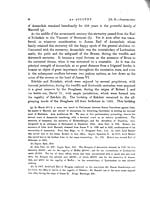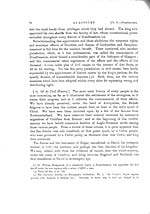Volume 5
(75) Page 69
Download files
Individual page:
Thumbnail gallery: Grid view | List view

69 and that regality were acquired by the Maxwell family, who held both throughout the sixteenth and seventeenth centuries (l). In 1610, John, Lord Maxwell, erected the town of Langholm into a "baronial burgh, whence the jurisdiction of Eskdale was sometimes called the regality of Langholm. After this regality was possessed by the family of Buccleuch, it was enlarged by the annexation of what had belonged, in upper Eskdale, to the monks of Melrose (m). In 1747 the Duke of Buccleuch was compensated for all this jurisdiction by the payment of �1400 sterling. In addition to those extensive jurisdictions, there existed, in various parts of this ample shire, other authorities of a more baronial kind and of less power (n). Those various and clashing jurisdictions seem all to have arisen after the conclusion of the Scoto-Saxon period, and during the long and degrading anarchy which was the natural result of the succession war. They continued to distract the sheriffdom and to distress the people, till their increasing abuses enforced an unwilling government to abolish them, by giving compensation to the proprietors for their profits, and resuming (l) During the latter half of the seventeenth century, however, there appears to have been a competition between the families of Nithsdale and Buccleuch for the right of that regality and the barony of Langholm. Inquis. Spec. 212, 242, 266, 346, 350. The Scots maintained their possession. (m) In 1676, Sir Francis Scot of Thirlstane was served heir to his father Patrick, in the estates and regality which formerly belonged to the monks of Melrose, and were then known by the name of the regality of Langholm or Eskdale. Inquis. Spec., 280. (w) The Carliles of Torthorwald had a baronial jurisdiction to which the Murrays of Cock- pool succeeded before the year 1509. There were other such jurisdictions of old in Annandale, but they were all absorbed long before the general abolition in the greater authorities. In Nithsdale, the Maxwell family had a baronial jurisdiction over all their estates in this country, which seems to have fallen with William, Earl of Nithsdale, in 1716. The monks of Holyrood had a baronial jurisdiction over their own estates, which, upon the decline of the ecclesiastical influence, was executed by the Maxwells as their baillies. This office was hereditary in that family; and William Maxwell, the son of the last earl, claimed in 1747, for that office, �1300, but he was allowed nothing. Inquis. Special., 25, 102, 266, 346. The Douglases of. Drum- lanrig, as hath been already intimated, collected and conjoined many estates in every part of this extensive shire into one regality, with ample powers of a free chapel and chancery, libera capella et cancel/aria;" and this was called the regality of Dalgarno. Inquis. Spec., 89, 344. 286, 353. This family also acquired in Nithsdale the estate and bailliery of Porterston, which continued a separate jurisdiction till the final abolition. It is remarkable that the Duke of Queensberry, who was to be compensated for all these jurisdictions, claimed for each authority what shows his estimate of the value of each ; for the regality of Dalgarno he claimed �8000, but he was only allowed �1621 8s. 5d. ; for the sheriffship of Dumfries he claimed �6000, and he was allowed �5000 ; for the bailliery of Porterston he claimed �500, but he was allowed nothing. MS. Report.
Set display mode to:
![]() Universal Viewer |
Universal Viewer | ![]() Mirador |
Large image | Transcription
Mirador |
Large image | Transcription
Images and transcriptions on this page, including medium image downloads, may be used under the Creative Commons Attribution 4.0 International Licence unless otherwise stated. ![]()
| Caledonia, or, An account, historical and topographic of North Britain from the most ancient to the present times > Volume 5 > (75) Page 69 |
|---|
| Permanent URL | https://digital.nls.uk/74530274 |
|---|---|
| Description | Vol. V. |
|---|---|
| Attribution and copyright: |
|

